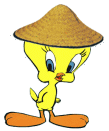
China
Beijing, "the northern capital"![[Unesco]](/images/unesco-logo.gif)
![[+]](/images/icone-etoile.png)
Beijing has been the capital of China, "the Middle Kingdom" since 1264.
It has been nicknamed "the northern capital" as opposed to Nankin, the
previous capital. When we think of Beijing, we often think of the great wall or the forbidden city...
Be aware of the distances as everything is vast, even the squares of large cities. Also be aware of weird proposals for visits
and prices asked by trishaw drivers. ![]() 5 day visiting schedule
5 day visiting schedule
Exemple of a 5 day visiting schedule :
1st day : Great Wall + Ming tombs
2nd day : Qianmen street + Tian'anmen square + Forbidden City + Coal Hill
3rd day : temple of Heaven + Summer Palace
4th day : Lamas temple + Olympic stadium
5th day : drum tower and bell tower neighborhood + Beihai park
Tips for the first day (check it in case of changes) :
1- Take the subway to Jishuitan then go to Deshengmen (early in the morning). There, take a bus 919 to Badaling.
Note 1 : there are several 919-X bus between Jishuitan and Deshengmen. It is better to ask to the drivers.
Note 2 : there would be no departure in the afternoon ?
2- From Badaling (late morning), take a bus 919 to Changling.
Then a bus 314 which serves the 3 main sites of the Ming tombs.
Note : the 314 bus stop is not next the 919 bus stop.
Either follow the road that leads to the center or take a taxi to the most remote tomb (Dingling) for about 30 yuan.
Then bus 314 to get to the other sites.
3- Return by bus 314 until a common station with a bus 919-X (to Changling) : ask the 314 ticket inspector for Beijing.
The great wall
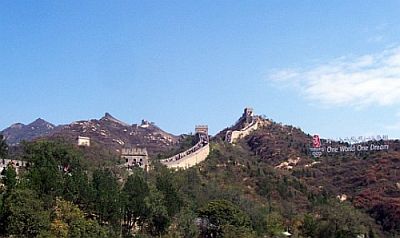
It is one of China's symbols. It is nicknamed : "long wall of the 10,000 lis". A Chinese saying is that :
"He who has never been to the great wall is not a true man". Nowadays it covers 6,700 km (4,150 miles) with an average height of 8 m (8.75 yards)
and a width of 6 m (6.5 yards).
Note : There are walls inside the walls.
The construction of the first walls dates from the 7th century B.C. but it is the emperor Qin Shi Huang, first emperor of China during the 3rd century B.C. (see Xi'an), who decided to join earth sections dating back several centuries ago in order to create a wooden great wall to prevent from being invaded by Mongols. But it didn't stop an invasion several centuries later... 300,000 soldiers and 500,000 convicts would have taken part in this work and 200,000 of them would have died because of it. This is why another nickname was given to it : "the longest graveyard in the world"...
It's finally the Ming emperors (14th-17th century) who finished building the great wall by extending it and consolidating it with bricks. It was then stretching over 10,000 km (6,200 miles) and 1 million men were helding it. They were able to communicate to one another thanks to a signal fire system. It was also a path for merchant caravans.
My visit was made in two stages : first I saw one of the inner gate in Juyong, and after this I went to the famous section of Badaling.
Ming tombs
It's vast and there are 13 tombs in all.
The sacred way (16th century) marks the beginning of the necropolis. There, everyone including the emporor dismounted. After the stele pavilion, the road itself is bordered with statues facing each other : lions, qilins (looking like a chimera), camels, elephants, xiezhis (looking like an unicorn), horses and soldiers.
The qilin is a fabulous and harmonious animal from the Chinese mythology. It brings good omen also have the power to give a talented son. It has the body of a deer, scales and oxtail. It is depicted with hooves or claws and can breathe fire.
According to the book of rites, four animals rule the animal world :
- the qilin over haired animals
- the phoenix over feathered animals
- the dragon over scaled animals
- the turtle over shelled animals
Note : not to be confused with the xiezhi, another mythical creature capable of distinguishing right from wrong.
The two most visited tombs are those of Dingling (underground palace and museum) and Changling.
Note : cruel, concubines were "buried" alive with the remains of the emperor...
The forbidden city
it's simply huge and amazing...
Below, a lion, guardian of the city, and the palace of supreme harmony.
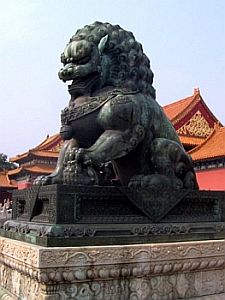
Among the buildings to visit, there are the apartments of the emperor, with of course the palace of the throne, palace of supreme harmony, and the apartments of his wives and concubines. Do not expect to spend less than 3 hours, or even a half day or more ...
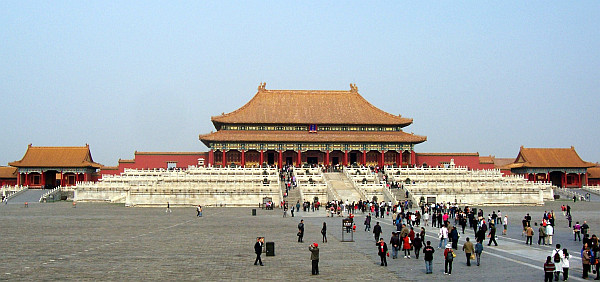
The emperor Yongle (Ming dynasty) had it built between 1407 and 1420 under the rules of feng shui and it covers 72 ha.
Feng shui shouldn't be confused with geomancy. While the latter is divination from natural elements, feng shui has for its aim to settle a favourable living place. For this, it is based on a study of energy flow (qi) taking into account among others the theory of the 5 elements also symbolized by astrological figures : water (black tortoise of the north), fire (vermilion bird of the south), wood (azure dragon of the east), metal (white tiger of the west) and earth (yellow dragon or rather yellow qilin of the center); and the Taoist yin and yang. Once the place located, changes are possibly made to render the energy "optimal" : it is the "acupuncture of the habitat"...
Symbolism was not set aside either : if there is a little less than 9,000 building, the goal was initially to have 9,999 of them as the 9 figure,
which is pronounced as the word "sustainable" in chinese, is a symbol of longevity in China. It can also be a symbol of perfection because it also symbolizes
Heaven (see ┬ž temple of Heaven) and thus was associated with the emperor, considered as the "son" of Heaven.
Besides, the Chinese had to prostrate 9 times before him and the painting of the city walls were purple which meant that it was a cosmic center.
The glazed tiles of all buildings are yellow, symbol colour of the emperor.
There was only an empress and the imperial harem was established around a hierarchy of 7 ranks (it was 12 between the 15th and 18th century) concerning wives as well
as concubines.
The city has not been inhabited since 1924. The staff was then composed of 1,000 eunuchs (against 20,000 under the Ming dynasty !).
Note : the wall with 9 dragons is not to be missed (see gallery).
Coal hill
This hill, nearby the forbidden city, was created to protect this latter from evil spirits coming from the north. People used to pile up coals at its foot, hence its nickname.
There are several pavilions and the one on the top of hill holds a buddha. But it is above all the view overlooking the Forbidden City that attracts our attention.
Temple of Heaven
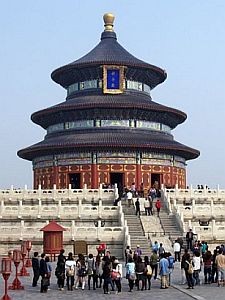
It is located in a large park where we can see people performing their tai chi, playing badminton (with racket or by foot), manipulating ribbon...
The temple is actually a complex of three buildings :
the altar of Heaven, which was the ceremonial center, the imperial vault of Heaven where were kept the tablets of Heaven and died emperors,
and the hall of prayer for good harvests (rotunda).
The altar of Heaven has the distinction of being built around the number 9 : 9 steps, 9 circumferences, and a number of tiles with a circumference in the multiple of 9.
The park has a square shape (which represents Earth) but the temples have a round shape (which represents Heaven), which corresponds to the principle of yin and yang.
This place was used to pay homage to Heaven in special occasions : solstice, first moon of the year; and also to seek for good harvest by the emperor himself.
Square Tian'anmen
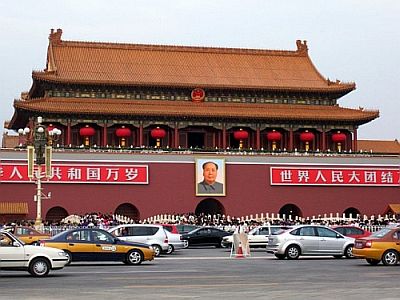
This huge square of 44 ha or 108 acres (440,000 m2 or 526,235 square yards), one of the largest in the world (I even thought that it was the largest but I have heard other places, also in China, are larger), can hold 1 million people and is the symbol of communist China.
It is bordered by the palace of People's assembly (west side), the National museum (east side), the Qianmen gates and the pretty
street in its extension (south side), the Beijing opera and the gate of Heavenly Peace allowing access to the Forbidden City and on which is fixed
an inevitable portrait of the great helmsman : Mao Zegong (north side). If we add that it is a great place of gathering, we can then understand its
nickname of "heart of China".
On the square itself, you can visit the mausoleum of Mao and see the monument to the heroes of the people.
It is also a remembrance place after that a mob of protesters (up to 1 million, including many students) willing to reform the system had been violently repressed by the army in 1989 causing between 1,000 and 3,000 deads.
Qianmen street
It is a great shopping street, south of Tian'anmen square. A must see !
Beihai park
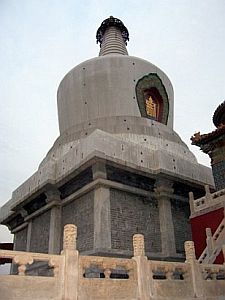
The development of this former imperial garden of over 69 hectares (170 acres) ,with more than half for the lake, began in the 10th century. Its name "Beihai" means "northern lake".
It is an ideal place for a stroll with palaces, temples and also the White Dagoba. This 40 m (131 feet) high stupa is located on an island. and was built with white stone. It contains sacred Buddhist scriptures.
Another curiosity not to be missed is the nine dragons wall. But watch out for timetables because access is not permanent, and too bad for me, I missed it... There are only two other walls with nine dragons in China : one in Beijing at the Forbidden City (phew, I saw that one) and another in Datong, but the only one with dragons on both sides is at Beihai park. The dragon, a guardian, is associated with number 9 : symbol of longevity in China.
So Beihai park is worth visiting for the ride and to get a glimpse of Chinese gardens. The most famous gardens are located in Suzhou.
Summer palace
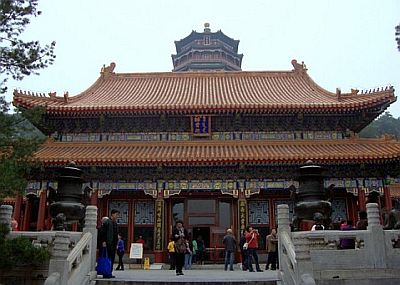
The summer palace was a resort in the capital for the emperor and especially the empress.
The first buildings date back to 1751 when emperor Qianlong (Qing dynasty) decided to build it to please his mother.
It was destroyed during the first Anglo-French invasion of 1860 and afterwards during the Boxer rebellion of 1900. It's empress Cixi who rebuilt it each
times respectively in 1886 and 1902.
The latest refurbishments date back to the olympic games of 2008.
Again, it is huge with palaces, pavilions and temples (18th century) and we can easily spend 4 hours there, and even more...
Lama temple
Wonderful ! with a giant statue of Maitreya Buddha (the Buddha of the future), statues of lamas with the Tibetan hat, prayer wheels ...
This is the largest lamaist worship place outside of Tibet. It is dedicated to Tsongkapa, the founder of the lama sect of the "Yellow hat" (Gelugpa)
predominant in Tibetan Buddhism.
Olympic stadium
These are the Olympic Park and Olympic Stadium used during the Olympic games started the 08.08.08 (2008). Again, everything is wide, with highly visited "bird's nest" (national stadium) and "cube" (olympic pool converted into amusement park).
More visits
-
Opera of Beijing
-
Bell tower and drum tower.
-
Hutongs : old neighborhoods of Beijing.
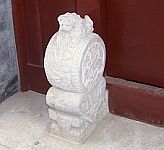
Beside, a mendun : round (most often) or rectangular stone used to support the "axles" of the doors.
In old Beijing neighborhoods, we can find menduns alone. They kept a symbolic meaning. Either they have a pattern whose meaning can be found by homonyms, either they give an indication about the social importance of the family : the higher the mendun big is the more important the family is...
-
Many sanlunches ("trailer" bicycle), trishaw ("pedicab" bicycle) and bikes.
